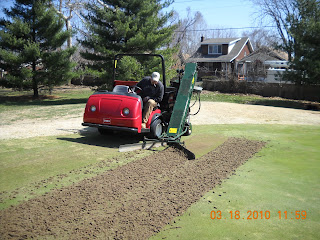We plan to aerate our greens on Monday and hopefully have the process complete on Tuesday. The course will be open on Tuesday for regular play. In preparing for this process, we have to check out our equipment to insure everything is set up properly. Our nursery green has a different base than our regular putting greens so we have to do a couple of passes on the very back of a green that is in play. I would use the practice green but it is the first part of the golf course that most people see so I prefer not have it partially aerated.
#4 is the green that we are using because of its easy access and the overall depth of the green which will allow us to keep the hole location toward the front for the next couple of days. We are also using our core harvester on a newer utility vehicle this season so it could be checked out as well. The new machine has a much lower PSI(pounds per square inch) weight which should reduce some of the tire imprinting that the much older 3 wheeled unit caused in past years. This will not eliminate the heaving because we are pulling cores at a depth of 6" but it should be reduced. The 6" deep aeration hole will allow roots to move down into the soil layer that is at about 3-5" of depth. Each green has a varied amount of depth of sand. As I have mentioned in the past, we are topdressing our greens with a sand that is more coarse than the sand that was used for many years. The existing sand has created a very tight water holding and oxygen starved root profile which reduces the ability of the greens to drain and keeps them very soft on the surface after rain events. The holes will be filled with the coarse sand during our process which will help to provide deep channels for roots to grow and moisture to be allowed to move through the root profile.
The pass on the right is at a depth of about 3". The pass on the left is full depth of about 6". You can see the diffence in material that is brought up to the surface.
Harry who is our mechanic is testing out the core harvester on our 4 wheel drive Toro Workman utility vehicle. It takes all hands on deck when aerating. Harry will be out with the rest of the crew during the process. The v-guide in the front directs the material up the conveyor belt where it is discarded into the back of the workman. The setup of the unit allows you to pick up the cores without driving upon them which makes it very difficult to pickup squashed plugs.
Harry with the worman and core harvester
The back view of the core harvester in action. The small conveyor belt shoots the material out into the back of the workman.
I will send out an email blast and make a blog post when the process is complete. Our greens will be sandy during the first few days after the process but I expect that they will play fine. I would believe the greens will be in good shape within 7 days and back to normal conditions within about 14 days. During the first few days after aeration, moisture or dew on the greens can cause sand to stick to the rollers on our greens unit and rolling unit so we must wait until the greens have dried substantially before we can place a mowing unit on the green. Because of the cool weather and growth regulators on our greens, they are not growing excessively as this time. The holes will be filled with sand which will allow the ball to roll out to the hole.
We appreciate your consideration during what I would consider the most important cultural practice that we perform to our greens during the season. The rest of our aeration work during the main growing season until the middle of October will be of the venting type. Small tines with very little surface disruption.



No comments:
Post a Comment